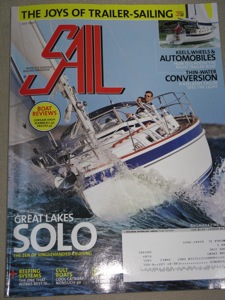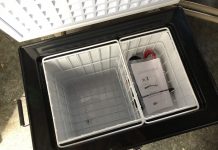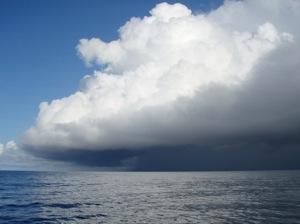It’s the best part of the day—relaxing in the cockpit with good friends, sharing another spectacular sunset with a cool drink. As the sun fades, growling stomachs remind us it’s time for dinner. Rather than jumping in the dinghy and heading ashore, though, we opt to lounge in our cockpit. Nothing is easier than lighting the grill and enjoying the tantalizing aromas that soon waft through the cockpit and drift over the anchorage.
Grilling is a great way to enjoy delicious foods with a minimum of cleanup, thanks to the fact that there are no pots and pans. No one misses the fun in the cockpit while slaving away in the galley, and no hot stove or oven means more comfortable sleeping on summer nights. As an added bonus, our grill uses camping-style propane canisters, which means it can act as a backup should our stove fail or we run out of the boat’s regular propane supply. I’ve never understood why more cruisers don’t use the grills perching on their transoms more often. My hope is that this article will entice you into taking the plunge, lighting up your grill and enjoying grilling’s culinary treasures and pleasures.
WHAT’S COOKING
You can grill just about anything you can cook inside on the galley stove or in the oven. We even bake bread and cookies on the grill to keep the oven heat out of the boat. There’s nothing better than a warm cookie in the cockpit after dinner. And who doesn’t love the smell and the taste of warm, homemade bread?
Everyone can relate to grilling hamburgers, pork chops, chicken and nice thick juicy steaks. But what about grilling tuna, grouper, snapper, lobster, shrimp or even pizza? (For a list of great grilling recipes, scroll down) It’s delicious with made-from-scratch dough and toppings comprised of what you already have aboard.
You can grill boat-size pizzas two at a time—each round having a different guest’s favorite toppings. Everyone gets to sample a hot slice, then the next one comes off the grill and everyone gets to taste test that one as well. Pizza takes 10-15 minutes to bake, so by the time the first slices are devoured and the drinks topped off, more hot pizza is ready.
For entertaining or holidays, grilling a turkey breast for the main course can be the perfect solution to feeding an entire family. Spicy and crispy outside, tender and juicy inside, grilled turkey is a wonderful way to keep the turkey out of the oven when preparing a holiday feast.
Jerk chicken kabobs are always a big hit to feed a cockpit full of friends. Consider turning any meal into a party by having everyone invited help prepare the kabobs in the cockpit. Cooking together can be lots of fun, and those who don’t want to help can be put in charge of refreshing drinks. Cockpit camaraderie is one of the best benefits of grilling and one reason we prefer eating aboard to going out.
If, by chance, the number of people for your get-together exceeds your cockpit capacity, consider moving the party to the beach where grilling recipes can easily be adapted for a beach barbecue.
CHARCOAL VS. GAS
Aboard Winterlude, we use a Magma Newport propane gas grill, because it is almost impossible to get charcoal in the Caribbean. Prior to leaving U.S. waters, we preferred a charcoal grill. I have grilled a wide range of recipes on both types, but prefer charcoal for the added flavor.
A gas grill is ready with a flick of a switch. It is also easier to control the temperature, and there are no worries about storing charcoal or lighter fluid. In a marina, you can grill with gas no matter which way the wind is blowing; with charcoal you could burn down the bimini, or worse. One major caveat with propane—make sure you have enough to finish grilling. There’s nothing worse than a barely grilled steak when the flames go out. We always keep a stock of about six camping canisters aboard. That way we never have to worry about running out of fuel. It’s easy to change out a canister in the middle of grilling, if necessary.
When grilling with charcoal, we prefer a combination of Kingsford-brand charcoal and lighter fluid—it seems to light easier and imparts no lighter fluid flavor to the food. If you use enough lighter fluid, you should have a nice hot fire within about 10 minutes.
After starting the fire, leave the lid off. We always leave the holes on the bottom open and control the fire with the holes on top: opening up the holes lets in more oxygen, which results in a hotter fire. When we’re finished grilling, we close the top holes completely to extinguish the fire. When grilling pizza, you need indirect heat, which means a ring of coals around the outside of the grill. For kabobs, we place a nice stack of charcoal in the middle, which both lights quickly and allows better airflow. The lid goes on after placing the food on the grill.
For general grilling, we turn everything every five minutes. To reduce the tendency to stick to the grill, we put the meat on, wait 30 seconds to a minute, then pick it up and lay it back down again. Grilled meat tastes better if it is allowed to reach room temperture before it is placed on the grill, and be sure not to puncture the meat during gripping—always use tongs or a spatula. Fork stabs allow precious juices to seep out, leaving your dinner dry and tasteless, and making your fire flare, creating needless tension.
Don’t bother cleaning your grill grates every time you use them. Grill grates are like a good cast-iron skillet; food tastes better when the grates are “seasoned.” We brush ours with a wire brush after each use, and only “clean” them every six months or so.
Again, always start grilling after the meat has reached room temperature and never leave meat unattended. The most common problem with grilling is not paying enough attention to the time. Chicken and pork chops tend to take about 15 minutes, or three turns to be done. Hamburgers also take about 15 minutes, a bit less for thinner ones. Steak, depending on the thickness, takes 10 minutes. Pork loin or roasts take longer, which can result in their becoming charred if you don’t turn them regularly.
After cooking, let the meat stand for five minutes. Don’t cut into it right away or you’ll lose the juices you worked so hard to save while grilling.
_______________________________________________________________________________________
SAFETY FIRST
Whether cooking with gas or charcoal, make sure nothing flammable is close to the grill. This includes your bimini as well as any canvas extensions, oven mitts, potholders, baggie clothing or food packaging. Always stay close to the grill while cooking. Keep a spray water bottle nearby for flare-ups. Baking soda is also good to have handy for extinguishing grease fires. Resist the temptation to open the lid too often—all the heat escapes.
TIPS FOR GAS GRILLS
Grilling accidents are rare, but when they occur, it is usually after the grill has not been used for a while—common with seasonal cruisers. Before using the grill, or after reattaching the grill’s gas container, take a minute to visually inspect all hoses for cracks, loose connections or blockages. Also check for gas leaks by turning on the gas and swabbing the connections and hoses with soapy water. If you see bubbles, fix the leak before using the grill.
If you smell propane while cooking, turn off the grill and do not reignite. Never check for propane leaks using a match. If a camping propane canister shows signs of excessive rust, gouges or bulges, switch it out for another. Use caution when storing propane tanks. If you use camping propane canisters, they should be stored upright in a dry and cool location. Never store tanks near the grill.
When lighting a gas grill, always keep the lid open to prevent gas from accumulating, which could result in a fire flash. If the burner doesn’t light, turn off the gas and wait several minutes before trying to light it again. If the burners go out while grilling, turn the gas off and wait a few minutes. Open the lid before relighting. When not in use, turn the propane off.
TIPS FOR CHARCOAL
Be aware that burning charcoal can generate carbon monoxide, an odorless, colorless, deadly gas. If you have a full cockpit enclosure, the grill should be located outside the enclosure, far enough away that fumes will blow away from, as opposed to into the cabin.
To start a fire, use solid firestarters or charcoal lighter fluid—never use kerosene or gasoline. Douse the coals generously and wait a minute for it to soak in before lighting. Never pour lighter fluid onto an already lit grill. Leave the lid off and the ventilation holes open until the initial flames burn down and the coals are covered with white ash. This should take about 10 minutes. Test the heat by holding your hand six inches above the grill rack. The fire is medium hot if you can hold your hand there for 3-4 seconds. Leave the ventilation holes open during grilling.
If you need to add charcoal once the grill is lit (you’ll need more every 40 minutes), use only regular charcoal briquettes; lumpwood charcoal burns too quickly and tends to flare up. Never add instant-light charcoal to an already lit grill. According to the charcoal manufacturer Kingsford, charcoal will only spontaneously combust at extremely high temperatures–not normal cruising temperatures, even in the tropics. Charcoal should be stored in a dry area to keep moisture from getting it. Seal it inside two or three plastic bags.

CLICK HERE TO VIEW SOME DELICIOUS RECIPES THAT INCLUDE:
Grilled Pizza
Blackened Turkey Breast
Jerk Chicken Kabobs
Homemade Jerk Marinade
DO YOU HAVE ANY SPECIALTY GRILLING RECIPES THAT YOU’D LIKE TO SHARE? PLEASE LEAVE THEM IN YOUR COMMENTS AND I’LL HAVE DAVID TRY THEM. WE’LL ADD A POST WITH RECIPES IF WE RECEIVE ENOUGH. THANKS!
If you liked this article, you may want to read Commuter Cruiser to Galley Manual Co-Author...













